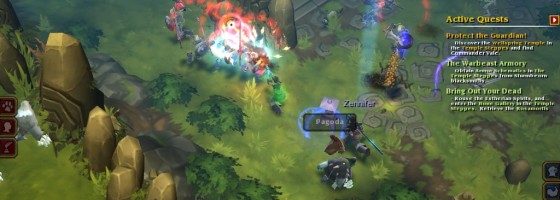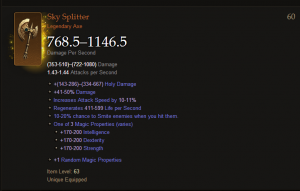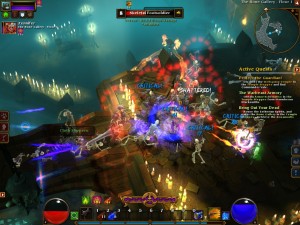This year for PC gamers was an ARPG smorgasbord, with titles like Drox Operative, Path of Exile beta and Borderlands 2 for instance. But the two that I find the most interesting are Diablo 3 and Torchlight 2.
With these two games we have an almost David vs. Goliath scenario. With Diablo 3 coming from Blizzard, which is arguably one of the biggest developers in the world. And Torchlight 2 from Runic games, which is helmed by the co founders of Blizzard North and the creator of Fate.
Both developers set out to create an ARPG of a similar mold. While on the outside both teams created a similar game, if we look closer there are very subtle differences that make it that much harder to pick a winner.
When it comes to ARPG design, there are three areas that we can judge them on: Character Design, Loot and Combat. When I started to break both titles down into these categories, the winner wasn’t as black and white as I hoped.
The Man/Woman Behind the Armor:
Class design is a major point in ARPG design, as this is what defines your abilities and search for loot. With both Torchlight 2 and Diablo 3, the designers had a different philosophy that wasn’t quite perfect.
In Diablo 3, each class was designed as a defined character, with a back-story, unique abilities that fit and preferred gear and attributes. When you played as a Barbarian, you were never going to use bow and arrows and equip quivers; likewise a Monk would never need a Witch Doctor’s sacrificial totem.
Abilities were set in stone in terms of their use, potential and utility and would never change. The rune system that allowed players to attach a skill modifying affect, while having a major impact, still only had set effects on the specific skills.
Meanwhile, Torchlight 2’s set of classes were more open and less defined. Each class had three skill trees unique to them, but was not restricted by gear. Meaning, if I wanted to take the engineer (heavy melee class) and use a ranged weapon that was fine.
One of the reasons for the openness was that there was no such thing as a primary attribute. Instead each one had an important purpose that could fit into the player’s style which I’ll be coming back to in the loot section.
The skills available to each class could be improved by investing skill points into them. Unlike Diablo 3, the skill’s basic functions are not set in stone and can be improved over time. Each skill has three tiers that the player can level them up to, which will increase the functionality of the respective skill.
For example one skill that weakens all enemies around the player for a few seconds will have its range increased with each tier. But at the same time, the duration and effect will go up with each skill point added.
Overall, to have to decide on a favorite of the two games, I’m split. On one hand, the better defined classes of Diablo 3 make them more unique and diverse, with a more varied selection of skills. But Torchlight 2’s ability to improve skills beyond their original functionality offers more customization and freedom in defining your character.
Looting Around:
Loot is a cornerstone of any ARPG: both as a form of progression and as a motivator for the player. If there is anything that can sink an ARPG faster, it’s not having good loot design. Once again looking at Torchlight 2 and Diablo 3, both titles have good ideas, but also some problems.
Let’s start with Diablo 3, here the rarity scale is: normal, magic, rare, set, and legendary. Going up the scale, items become more powerful, have greater stats and at set and higher may have special abilities.
The most important factor when determining what is considered good loot for a character is if it provides a bonus to the class’s primary attribute. As the primary attribute not only affects how much damage the character can do, but also is a factor of their defense.
When the player reaches the end game of Diablo 3 with the current cap of level 60, loot continues to level up three more times to a total of level 63.
Now, level 60 and up items don’t appear until the player is in the final act of Hell difficulty (second hardest difficulty).
The increase in stats from 60 to 63 is huge, as weapons can start providing thousands of extra points of damage with a major defense increase to boot.
Torchlight 2 handles things abit differently. First is that the rarity scale is condensed to just: normal, magic, rare and legendary with set items appearing in rare. Because there is no such thing as a primary attribute, a character can equip any weapon that they want. The strength attribute does affect how much physical damage a player can do, while focus affects magical. But the main determination of a weapon’s damage is the actual damage stat on the weapon.
Because of that, the player has more freedom in finding loot as they aren’t restricted by one attribute. Good loot can be found anywhere, and the world of Torchlight 2 is randomized with each game. The player can also reshuffle cleared areas to make them new again. Throughout the game, the player may find enemies called phase beasts, that when killed will open up a portal to another area where the player can find more loot.
The problems with loot design between the two games are a simple matter of missing the target of keeping loot varied and improving. Diablo 3 falls short of the target while Torchlight 2 overshot it.
In Diablo 3, the chance to find loot that can provide any kind of upgrade to your character becomes more and more limited the further you play. The reason is due to the reliance of the primary attribute. It doesn’t matter at all what the other stats are for a weapon (and in some cases equipment,) as without the primary attribute the item won’t be anywhere as effective as those with it.
On the flip side, Torchlight 2’s loot problem is that the window of finding upgrades is too wide and makes the feeling of finding new equipment lessen. The reason is that since there isn’t a focus on what attributes are needed for gear (with exception to damage and armor on weapons and equipment respectively), you’re free to use whatever you want.
However, while it gives the player more freedom in finding items, it also makes it hard to find meaningful upgrades – or pure upgrades. In Diablo 3 it’s very easy to see what gear would be better or worse for your character. But in Torchlight 2, it’s very easy to be overwhelmed by different gear for the same slot with minute differences.
Another problem is that loot doesn’t scale up as quickly in Torchlight 2 compared to other action rpgs. If I’m in a level 28-30 area, I may still find loot for level 24 and below dropped by enemies. Due to how varied the loot table is, that level 24 item may be as good as something around level 29, but the chance of that is less, compared to finding something of a higher level.
In terms of both games I would give the nod to Torchlight 2. As having more choices is always better than less, and the random world design mixes things up better then what is currently in Diablo 3.
For the last category: combat, this can be a tricky one to look at. This is hard to examine something while you’re being surrounded by dozens of monsters.
Calculating Combat:
Combat seems like something so simple in an action rpg, but there is a lot of subtlety hidden under the surface. We could actually have a full post related just to talking about what goes into making combat interesting.
There is no point in explaining combat in Diablo 3 and Torchlight 2 before talking about them in depth, as both use similar systems. The key difference is how combat flows in either game.
In Diablo 3, combat is just a tad slower pace than Torchlight 2. Granted on the higher difficulty levels, one mistake can leave you dead or close to it. However enemies move and react slow enough that the player has a chance to use a skill or actively avoid a high damaging attack.
The use of the skill system allows the player to define their move-set for any given fight: Focusing on area of effect skills, direct damage, slowdown and many more.
And the combat is slow enough that you can set up attack strategies like putting down a slow trap as a Demon Hunter, and following it up grenades when the enemies are grouped up.
Torchlight 2 plays at a faster pace, with more enemies attacking per group compared to Diablo 3. Due to the pace, it is harder to set up skills in a strategy as enemies will quickly close the gap and do damage. Ranged projectiles fly a lot faster and in more numbers, making it harder to actively dodge them while attacking.
Because the general size of the enemy on screen is smaller in Torchlight 2 compared to D3, it makes it easier to lose enemies in a crowd of special effects. During a boss fight for instance, I went from full health to dead in one second and I had no idea what actually happened.
Granted I’ve had the same thing happen to me in Diablo 3 inferno mode, but I was at least able to see it coming before dying horribly.
The Final Tally:
When I first started writing this post last week, I was leaning towards Torchlight 2 being the better ARPG of the two. However, after spending the weekend playing both games I have to give a slight nod to Diablo 3.
The reason is that while both games have design problems, the issues that I have with Diablo 3 (loot, more randomness to world) are easier to fix then Torchlight 2’s problems (combat pacing, class refinement.)
With that said however, it’s not exactly a clear win by Diablo 3, as both titles are good for the genre and are neck in neck in terms of edging out the other one for the top position. With a Diablo 3 expansion planned and more patches, it will be interesting to see how the game will change from launch in a year’s time.




Pingback: Perceptive Podcast : A Humble Loot Hunt for City Builders | Game Wisdom()